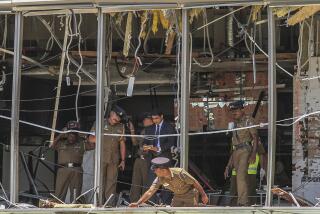Gandhi Probers Seize Videotape From Rally : India: The film reportedly records the assassination. Authorities arrest a number of Sri Lankan insurgents.
NEW DELHI — Investigators seeking the identity of the suicide bomber who killed Rajiv Gandhi seized a videotape Saturday that reportedly recorded the act of assassination, and Indian authorities arrested a number of Sri Lankan Tamil insurgents based in south India.
The identities of those detained, among them the cameraman who videotaped the election rally where Gandhi was killed, were withheld by police, as was the number of Sri Lankan militants rounded up. But India’s independent United News of India news agency said the special team of intelligence agents and detectives investigating Gandhi’s murder viewed the footage, which contained frames of Gandhi’s killing, before the arrests were made.
Among the images in the videotape were clear pictures of Gandhi’s suspected assassin, a young woman who forensic experts have said was carrying three sticks of high explosives in the back of a denim belt strapped to her waist. The assassin detonated the explosives when she bowed in front of Gandhi as he arrived for a campaign rally Tuesday night.
In a press conference Saturday evening, T.V. Anthony, the most senior bureaucrat in the Indian state of Tamil Nadu where Gandhi was killed, said the investigation into his death had been handed over to an intelligence team from New Delhi and that all officials had been told not to comment to the press.
Defending police security mounted by the state at the scene of the rally in the village of Sriperumbudur, Anthony said that the police officers who suffered injuries in the explosion were proof that the state did its best to protect a leader who insisted on getting as close to his supporters as possible.
In an effort to blunt widespread speculation that Gandhi’s assassination was engineered by the Sri Lankan insurgent group, the Liberation Tigers of Tamil Eelam, Anthony added: “There is no evidence of L.T.T.E. activities anywhere in Tamil Nadu for the last few months, and even villages in coastal areas have confirmed this.”
The strife-torn Indian Ocean island nation of Sri Lanka lies just 23 miles off Tamil Nadu’s southern coast, and Gandhi has been near the top of the Tamil Tigers’ hate list since he sent an Indian army peacekeeping force into the Tamil-dominated northern sector of the island. That deployment took place under an agreement Gandhi signed with the Sri Lankan government in 1987, and within months Indian troops found themselves locked in combat with the Tamil insurgents.
In a separate press conference in the Tamil Nadu state capital of Madras on Saturday, a state political leader opposing a local alliance with Gandhi’s Congress-I Party told reporters that the 46-year-old Indian leader was no longer an enemy of the Tamil Tigers at the time of his death.
M. Karunanidhi, head of an Indian Tamil political party aligned with political forces opposed to Congress-I, insisted that Gandhi recently made peace with the Tigers. His statement was bolstered by a report Saturday in The Hindu, a respected national newspaper published from Madras.
The newspaper said that on March 5, Gandhi met with a senior Tiger central committee member in New Delhi, where the insurgent leader “told him that the militant organization wanted to forget the past and open a new chapter in relations with him. He told the former prime minister that the situation on the island had deteriorated alarmingly, with the L.T.T.E. coming under severe pressure.”
In an interview Thursday, the state’s Congress-I chief, K. Rama Murthy, called Tamil Nadu “the launching pad” for the continuing Tamil insurgency against Sri Lankan authorities.
The United News of India, which reported the “unspecified number” of Tamil Tiger arrests in the state, said that their identity and location is being withheld by the federal government investigators who ordered their arrest.
Similarly, state authorities refused to identify the local cameraman who filmed the rally where Gandhi was assassinated, saying only that the videocassette had been seized, viewed and analyzed by investigators and that the cameraman, apparently hired by Gandhi’s party to film the event, was being interrogated. The agency added that the video contains “frames of the sequence leading to the blast” that killed Gandhi and at least 16 others who were standing nearby when the suicide bomber detonated the device.
More to Read
Sign up for Essential California
The most important California stories and recommendations in your inbox every morning.
You may occasionally receive promotional content from the Los Angeles Times.










